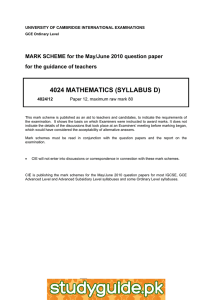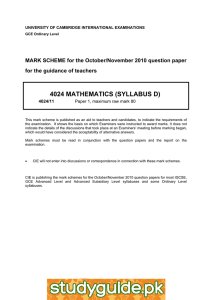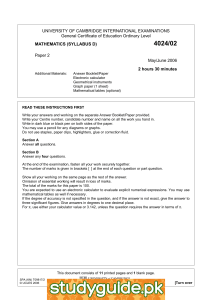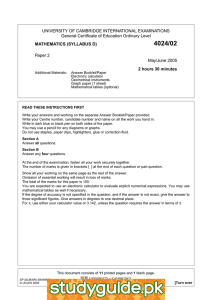UNIVERSITY OF CAMBRIDGE INTERNATIONAL EXAMINATIONS 4024/11 General Certificate of Education Ordinary Level
advertisement
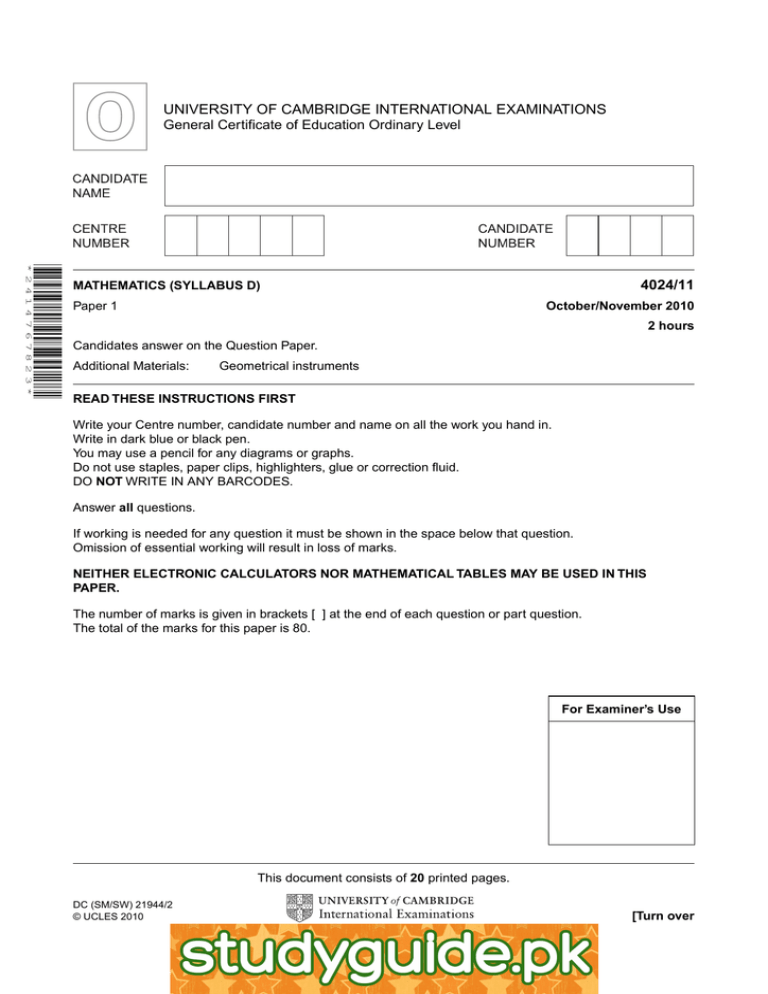
UNIVERSITY OF CAMBRIDGE INTERNATIONAL EXAMINATIONS General Certificate of Education Ordinary Level *2414 767823* 4024/11 MATHEMATICS (SYLLABUS D) Paper 1 October/November 2010 2 hours Candidates answer on the Question Paper. Additional Materials: Geometrical instruments READ THESE INSTRUCTIONS FIRST Write your Centre number, candidate number and name on all the work you hand in. Write in dark blue or black pen. You may use a pencil for any diagrams or graphs. Do not use staples, paper clips, highlighters, glue or correction fluid. DO NOT WRITE IN ANY BARCODES. Answer all questions. If working is needed for any question it must be shown in the space below that question. Omission of essential working will result in loss of marks. NEITHER ELECTRONIC CALCULATORS NOR MATHEMATICAL TABLES MAY BE USED IN THIS PAPER. The number of marks is given in brackets [ ] at the end of each question or part question. The total of the marks for this paper is 80. For Examiner’s Use This document consists of 20 printed pages. DC (SM/SW) 21944/2 © UCLES 2010 [Turn over www.XtremePapers.net 2 NEITHER ELECTRONIC CALCULATORS NOR MATHEMATICAL TABLES MAY BE USED IN THIS PAPER. 1 (a) Evaluate 35 – 27.3 . Answer (a) ....................................... [1] (b) Evaluate 1.3 × 0.03 . Answer (b) ....................................... [1] 2 (a) Evaluate 1 + 3 . 3 7 Answer (a) ....................................... [1] (b) Evaluate 2 ÷ 2 2 . 3 Answer (b) ....................................... [1] © UCLES 2010 4024/11/O/N/10 www.XtremePapers.net For Examiner’s Use 3 3 (a) Express 60% as a fraction, giving your answer in its lowest terms. For Examiner’s Use Answer (a) ....................................... [1] (b) The mass of a jar and its contents is 1.6 kg. The contents have a mass of 875 grams. Calculate the mass, in grams, of the jar. Answer (b) ................................. g [1] 4 (a) Evaluate 40 + 41 . Answer (a) ....................................... [1] (b) Evaluate 冢 14 冣 –2 . Answer (b) ....................................... [1] © UCLES 2010 4024/11/O/N/10 www.XtremePapers.net [Turn over 4 5 (a) In the diagram in the answer space, two small squares are shaded. For Examiner’s Use Shade one more small square, so that the figure will then have one line of symmetry. Answer (a) [1] (b) In the diagram in the answer space, two small triangles are shaded. Shade four more small triangles, so that the figure will then have rotational symmetry of order 3. Answer (b) [1] 6 The length of a side of an equilateral triangle is given as 41 mm, correct to the nearest millimetre. (a) Write down the lower bound for the length of a side. Answer (a) ............................. mm [1] (b) Giving your answer in centimetres, calculate the lower bound for the perimeter of the triangle. Answer (b) .............................. cm [1] © UCLES 2010 4024/11/O/N/10 www.XtremePapers.net 5 7 y varies inversely as the square of x. Given that y = 4 when x = 3, find the value of y when x = 2. For Examiner’s Use Answer y = ...................................... [2] 8 By writing each number correct to one significant figure, estimate the value of 0.387 × 7.032 . 3 8.11 Answer ............................................ [2] © UCLES 2010 4024/11/O/N/10 www.XtremePapers.net [Turn over 6 9 (a) Solve the inequality 18 – 3x < x . For Examiner’s Use Answer (a) x .................................... [1] (b) Given that n is an integer, where –10 艋 3n < –3 , find the possible values of n. Answer (b) n = ................................ [1] 10 The temperatures, in °C, at midnight on 12 consecutive days were –1, 0, – 4, 1, 2, –2 –1, –3, 1, 2, 3, 2 . (a) Find the mode of these temperatures. Answer (a) ................................°C [1] (b) Find the median of these temperatures. Answer (b) ................................°C [1] © UCLES 2010 4024/11/O/N/10 www.XtremePapers.net 7 11 The diagram shows three parallel lines. 74° z° For Examiner’s Use y° x° 140° (a) Find x. Answer (a) x = ................................. [1] (b) Find y. Answer (b) y = ................................. [1] (c) Find z. Answer (c) z = ................................. [1] 12 (a) Remove the brackets and simplify 4(7x – 3) – 3(5x – 4) . Answer (a) ....................................... [1] (b) Express as a single fraction in its simplest form 4 5 – . 3y 4y Answer (b) ....................................... [1] (c) Simplify (4a2b) × (3ab3) . Answer (c) ....................................... [1] © UCLES 2010 4024/11/O/N/10 www.XtremePapers.net [Turn over 8 13 (a) Factorise completely 16a2 – 6a . For Examiner’s Use Answer (a) ....................................... [1] (b) Factorise completely 6x + 3xy – 4y – 8 . Answer (b) ....................................................[2] 14 The speed of light is given as 3 × 105 km/s. Writing each answer in standard form, calculate (a) the distance, in kilometres, that light travels in one minute, Answer (a) ........................................... km [1] (b) the time, in seconds, that light takes to travel 150 km. Answer (b) ................................... seconds [2] © UCLES 2010 4024/11/O/N/10 www.XtremePapers.net 9 15 The diagram shows a sector of a circle, centre O. The radius of the circle is 9 cm and the sector angle is 100°. Taking the value of π to be 3.14, calculate A For Examiner’s Use 9 (a) the length of the arc AB, 100° O B Answer (a) .............................. cm [2] (b) the perimeter of the sector. Answer (b) .............................. cm [1] 16 The lines 3y + x = 3 and y = x + 3 are shown in the diagram below. (a) Find the gradient of the line 3y + x = 3. Answer (a) ....................................... [1] (b) On the diagram shade, and label with the letter R, the region defined by the inequalities 3y + x 艌 3, y 艋 x + 3, x艌0. Answer (b) y 4 3 2 1 –4 –3 –2 –1 0 1 2 3 4 5 x –1 [2] © UCLES 2010 4024/11/O/N/10 www.XtremePapers.net [Turn over 10 17 A = 冢 4 –3 0 0 6 –2 冣 B= 冢 5 – 4 –1 0 6 2 冣 C = (2 For Examiner’s Use 1) (a) Find 2A – B . Answer (a) [2] Answer (b) [1] (b) Find CA . © UCLES 2010 4024/11/O/N/10 www.XtremePapers.net 11 18 Solve the simultaneous equations For Examiner’s Use x + 2y = 8 , 1 y= x+9. 3 Answer x = ...................................... y = ...................................... [3] © UCLES 2010 4024/11/O/N/10 www.XtremePapers.net [Turn over 12 19 Two bags contain beads. The first bag contains 2 black and 3 white beads. The second bag contains 2 black, 1 white and 2 red beads. A bead is taken, at random, from each bag. The tree diagram that represents these outcomes is drawn below. First bag 2 5 Second bag black 2 5 1 5 2 5 3 5 For Examiner’s Use white 2 5 1 5 2 5 black white red black white red Giving each answer in its simplest form, find the probability that (a) both beads are black, Answer (a) ....................................... [1] (b) both beads are red, Answer (b) ....................................... [1] (c) exactly one bead is black. Answer (c) ....................................... [2] © UCLES 2010 4024/11/O/N/10 www.XtremePapers.net 13 20 M is the midpoint of the line joining P and Q. For Examiner’s Use (a) R lies on PQ produced, such that PR = 3PQ . Find PM : PR . Answer (a) .................. : ..................[1] (b) P is ( 1, –2 ) and Q is ( 5, 6 ) . (i) Find the coordinates of M. Answer (b)(i) (............. , .............) [1] (ii) The line 4x + ky + 10 = 0 passes through Q ( 5, 6 ) . Find the value of k. Answer (b)(ii) k = ............................ [2] © UCLES 2010 4024/11/O/N/10 www.XtremePapers.net [Turn over 14 21 D sin b° 0.85 cos b° 0.53 tan b° 1.6 4 A b° B C In the diagram, ABC is a straight line. BD = 4 cm, BĈD = 90° and CB̂D = b°. Use as much information given in the table as is necessary to answer the following questions. (a) Calculate the value of sin AB̂D + cos AB̂D. Answer (a) ....................................... [2] (b) Calculate BC. Answer (b) BC = .................... cm [2] © UCLES 2010 4024/11/O/N/10 www.XtremePapers.net For Examiner’s Use 15 22 The grouped frequency table below shows the times taken for 70 students to solve a problem. For Examiner’s Use Time (t minutes) 0⬍t 艋3 3⬍t 艋4 4⬍t 艋5 5⬍t 艋6 6⬍t 艋8 Number of students 24 12 16 10 8 t艋6 t艋8 (a) Complete the cumulative frequency table for this information. Answer (a) Time (t minutes) t艋3 Number of students 24 t艋4 t艋5 [1] (b) In which group of the frequency table does the 40th percentile lie? Answer (b) ....................................... [1] (c) Complete the frequency density table for this information. Answer (c) Time (t minutes) 0⬍t 艋3 3⬍t 艋4 4⬍t 艋5 Frequency density 8 12 16 5⬍t 艋6 6⬍t 艋8 [2] © UCLES 2010 4024/11/O/N/10 www.XtremePapers.net [Turn over 16 23 Look at this pattern. 22 – 02 = 4×1 32 – 12 = 4×2 42 – 22 = 4×3 52 – 32 = 4×4 For Examiner’s Use (a) Write down the 7th line of the pattern. Answer (a) ........................................................................................................................... [1] (b) Write down the n th line of the pattern. Answer (b) ........................................................................................................................... [1] (c) Use the pattern to find 5212 – 5192 . Answer (c) ....................................... [1] (d) Use the pattern to find the positive integers x and y such that x2 – y2 = 484 . Answer (d) x = ................................. y = ................................. [1] © UCLES 2010 4024/11/O/N/10 www.XtremePapers.net 17 24 The diagram below shows triangle A and triangle B. For Examiner’s Use (a) Describe fully the single transformation that maps triangle A onto triangle B. Answer (a) ................................................................................................................................ ................................................................................................................................................... .............................................................................................................................................. [2] (b) Triangle A is mapped onto triangle C by a rotation, centre the origin, through 90° anticlockwise. (i) Draw, and label, triangle C on the diagram. Answer (b)(i) y 3 2 A 1 –3 –2 –1 0 1 2 3x –1 –2 –3 B –4 [1] (ii) Write down the matrix that represents this transformation. Answer (b)(ii) © UCLES 2010 4024/11/O/N/10 www.XtremePapers.net [1] [Turn over 18 25 For Examiner’s Use 6 Speed 4 (m/s) 2 0 0 5 10 15 Time (t seconds) 20 25 The diagram is the speed-time graph of the last 25 seconds of a car’s journey. From t = 0 to t = 20 the car moves with a constant speed of 4 m/s. From t = 20 to t = 25 the car moves with a constant retardation. (a) Calculate the retardation when t = 22.5. Answer (a) ............................ m/s2 [1] (b) Show that the distance travelled during the 25 seconds is 90 m. Answer (b) ................................................................................................................................ ................................................................................................................................................... ................................................................................................................................................... ................................................................................................................................................... .............................................................................................................................................. [1] (c) On the grid below, draw the distance-time graph for the 25 seconds. Answer (c) 100 80 Distance (metres) 60 40 20 0 0 5 10 15 Time (t seconds) 20 25 [2] © UCLES 2010 4024/11/O/N/10 www.XtremePapers.net 19 26 A For Examiner’s Use D 4 B C 6 The diagram shows triangle ABC. D is the point on AB such that BĈD = BÂC. (a) Explain why triangle ABC is similar to triangle CBD. Answer (a) ................................................................................................................................. ................................................................................................................................................... ................................................................................................................................................... ................................................................................................................................................... .............................................................................................................................................. [1] (b) Given that BD = 4 cm and BC = 6 cm, calculate AD. Answer (b) AD = .................... cm [3] Question 27 is printed on the following page © UCLES 2010 4024/11/O/N/10 www.XtremePapers.net [Turn over 20 27 The diagram below shows triangle ABC. For Examiner’s Use (a) Measure AB̂C. Answer (a) AB̂C = ............................ [1] (b) On the diagram, construct the locus of points inside the triangle that are (i) 8 cm f rom C, [1] (ii) equidistant from AB and AC. [1] (c) On the diagram, shade the region inside the triangle containing the points that are more than 8 cm f rom C and nearer to AB than to AC. [1] Answer (b),(c) B A C Permission to reproduce items where third-party owned material protected by copyright is included has been sought and cleared where possible. Every reasonable effort has been made by the publisher (UCLES) to trace copyright holders, but if any items requiring clearance have unwittingly been included, the publisher will be pleased to make amends at the earliest possible opportunity. University of Cambridge International Examinations is part of the Cambridge Assessment Group. Cambridge Assessment is the brand name of University of Cambridge Local Examinations Syndicate (UCLES), which is itself a department of the University of Cambridge. © UCLES 2010 4024/11/O/N/10 www.XtremePapers.net
